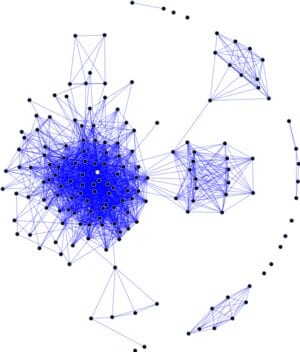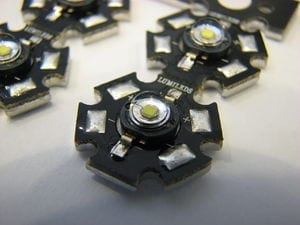
The answer is yes, according to a paper in the SIAM Journal on Discrete Mathematics.
In a paper published in the journal last month, authors Anthony Bonato, Dieter Mitsche, and Pawel Pralat describe a mathematical model to disrupt flow of information in a complex real-world network, such as a terrorist organization, using minimal resources.
Terror networks are comparable in their structure to hierarchical organization in companies and certain online social networks, where information flows in one direction from a source, which produces the information or data, downwards to sinks, which consume it. Such networks are called hierarchical social networks.
“In such networks, the flow of information is often one way,” explains author Pawel Pralat. “For example, a celebrity such as Justin Bieber sends out a tweet, which is sent to millions of his followers. These followers send out their own retweets, and so on. We may therefore view hierarchical social networks as directed networks without cycles, or directed acyclic graphs (DAGs).”
Here, there is no requirement for reciprocity (the celebrity does not necessarily follow his or her followers). Similarly, in a terrorist network, the leaders pass plans down to the foot soldiers, and usually only one messenger needs to receive the message for the plan to be executed.
Disruption of the flow of information would correspond to halting the spread of news in an online social network or intercepting messages in a terror network.
The authors propose a generalized stochastic model for the flow and disruption of information based on a two-player outdoor game called “Seepage,” where players who depict agents attempt to block the movement of another player, an intruder, from a source node to a sink. “The game—motivated by the 1973 eruption of the Eldfell volcano in Iceland—displays some similarities to an approach used in mathematical counterterrorism, where special kinds of DAGs are used to model the disruption of terrorist cells,” says Pralat.
The motivating eruption caused a major crisis at the time, as lava flow threatened to close off the harbor, the island’s main source of income. In the game, inhabitants attempt to protect the harbor by pouring water on the volcanic lava to halt its progress. A mathematical model of the game pits two opponents against each other—the sludge, or intruder, against the greens, or agents— forming a directed acyclic graph, with one source (the top of the volcano) and many sinks representing the lake. The parameter, “seepage,” represents the amount of contamination, and the “green number” corresponds to the number of agents required to halt it.
A previous study modeled terrorist cells as partially ordered sets (a special kind of DAG), which are often used in mathematics to analyze an ordering, sequencing, or arrangement of distinct objects. In such a system, terrorist plans are formulated by nodes at the top of the hierarchy, which represent the leaders or maximal nodes of the set. The plans are transmitted down to the nodes at the bottom: these represent foot soldiers in a terror network or minimal nodes in the set who would be presumed to carry out these plans. The assumption is that one messenger is sufficient for reception and execution of the plan. Thus, if the partially ordered set represents a courier network for a terrorist organization, the intention would be to block all routes from the maximal node to the minimal nodes by capturing or killing a subset of agents.
In this paper, the authors utilize the similarities in the previous terrorist cell model to Seepage, where greens try to prevent the sludge from moving to the sinks by blocking nodes. A number of different winning strategies employed by both players are explored when played on a DAG. The seepage and green number for disrupting a given hierarchical social network are analyzed.
The primary difference from the previous study’s model is that the Seepage model is dynamic: greens can move and choose new sets of nodes over time. The authors determine that Seepage is a more realistic model of counterterrorism, as the agents do not necessarily act all at once, but over time.
The Latest Bing News on:
Detect terrorism networks
- Accurate Insights from Director Gacki: Strengthening AML/CFT Regulationson May 7, 2024 at 11:49 pm
By fostering collaboration and information sharing, FinCEN aims to enhance the collective ability of financial institutions to detect ... networks and safeguard national security interests. Gacki ...
- Iraq executes 11 people convicted of terrorism, two security sources sayon May 6, 2024 at 9:16 am
Eleven people were executed on Monday at a prison in the southern Iraqi city of Nassiriya after they were convicted and sentenced to death of terrorism crimes, two security sources have told Reuters.
- How AI is transforming the battle against fincrimeon May 6, 2024 at 8:30 am
Instant AI-powered solutions enable organisations to monitor customer risk profiles and activities in real-time.
- Preventing Terror Acts Is Considered Successful, "Lone Wolf" Is Worth Watchingon May 4, 2024 at 4:58 am
"They are impulsive, emotional, take action out of superficial solidarity and jihad," said Khairul regarding "lone wolves".
- Global tapestry and impact of terrorismon May 3, 2024 at 5:01 pm
In an era marked by geopolitical upheavals and regional conflicts, the spectre of terror looms large, transcending borders and threatening stability on a global scale ...
- NYPD Pushes Ridiculous Conspiracy About Columbia University Protestson May 1, 2024 at 2:55 pm
At UCLA, counterprotesters attacked the student-led encampment Tuesday night by tearing down barricades and plywood surrounding it. They shouted, “Second Nakba!” referring to the mass displacement and ...
- Beware, global jihadists are back on the marchon April 29, 2024 at 8:29 am
But extremists are on the march again. They have re-emerged in havens old and new, and are thriving in cyberspace. Furthermore, Israel’s war in Gaza is all but certain to radicalise a new generation.
- Trial begins for 9 in Germany over alleged coup ploton April 29, 2024 at 3:40 am
German Interior Minister Nancy Faeser said on ZDF public television that the trial "shows the strength of our rule of law that the largest terrorist network of Reich Citizens to date ...
- Tinubu blames illegal mining for terrorism fundingon April 22, 2024 at 8:36 pm
Tinubu’s comments follow the increasing sophistication of terrorist networks and their affiliates ... enhance the country’s capacity to detect, prevent, and respond to terrorist threats.
- Nigeria to boost collaboration, disrupt terrorism-fueling trafficking - Tinubuon April 22, 2024 at 9:57 am
Tinubu said, “Dedicated to coordinating and implementing counter-terrorism strategies, the NCTC significantly enhances our capacity to detect ... illicit trafficking networks that fuel terrorism ...
The Latest Google Headlines on:
Detect terrorism networks
[google_news title=”” keyword=”detect terrorism networks” num_posts=”10″ blurb_length=”0″ show_thumb=”left”]
The Latest Bing News on:
Terror networks
- FinCEN Issues Advisory on Iran-Backed Terrorist Organizationson May 8, 2024 at 6:28 pm
Today, in light of intensified terrorist activity in the Middle East, the U.S. Department of the Treasury’s Financial Crimes Enforcement Network (FinCEN) issued an Advisory to assist financial ...
- FinCEN warns financial institutions on Iran-backed terrorist organizationson May 8, 2024 at 6:47 am
The Treasury Department’s Financial Crimes Enforcement Network (FinCEN) advised financial institutions in detecting illicit transactions related to Iran-backed terrorist organizations. The agency’s ...
- Israeli troops launch counter-terror operation in West Bank city Tulkaremon May 5, 2024 at 10:53 pm
The Israeli military and Border Police launched a large counter-terrorism operation in the West Bank city of Tulkarem overnight.According to military sources, the operation is aimed at dismantling a ...
- DIG reviews intel network, anti-terror operation in Rajourion May 3, 2024 at 6:10 pm
In a bid to bolster the ongoing anti-terrorist operations and oversee the efficiency of the intelligence network in Rajouri, a comprehensive ...
- Judge denies bail to teen charged with terror-related offenses after stabbings at Sydney churchon May 2, 2024 at 12:02 am
A judge has denied bail to a 15-year-old boy alleged to be in a network planning terrorist acts and who claimed to be a friend of another teen accused of stabbing a Sydney bishop ...
- Keffiyeh Karen whines for glass of water, proving pro-terror students are total weaklingson May 1, 2024 at 8:08 am
Slutzky implied to the press that the illegal occupiers of Hamilton Hall were going to die of dehydration and starvation unless they got snacks and ...
- Afghan resistance leader warns attack on American soil ‘not a matter of if but when’on May 1, 2024 at 3:06 am
The leader of an armed resistance against the Taliban’s rule in Afghanistan has warned the US and Europe about rising threats of attacks by terror outfits ...
- Columbia students denied access to dining halls, food as pro-terror rioters force campus lockdownon April 30, 2024 at 9:15 am
Only students who lived in residential buildings on the Morningside Heights campus, as well as “essential” staff, were being allowed in as of Tuesday morning, Columbia officials said.
- Influential former IS supporter Wassim Fayad drawn into probe of alleged Sydney teen terror networkon April 25, 2024 at 12:55 am
An influential former Islamic State supporter who was released from a supervision order last year was questioned in Wednesday's police raids on an alleged terrorism network involving a group of Sydney ...
The Latest Google Headlines on:
Terror networks
[google_news title=”” keyword=”Terror networks” num_posts=”10″ blurb_length=”0″ show_thumb=”left”]










